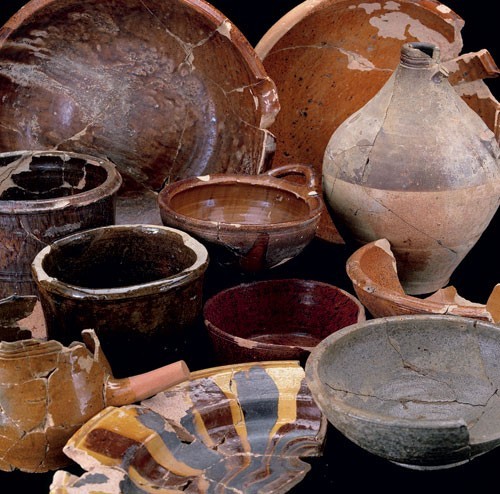
Earthenware and stoneware “wasters” recovered from the William Rogers site in Yorktown, Virginia, ca. 1720–1745. (Courtesy, National Park Service, Colonial National Historical Park, Yorktown Collection; all artifact photos by Gavin Ashworth.)

Photograph showing the initial stages of the excavation of one of several waster pits discovered on the site. (Photo, Norman F. Barka.)
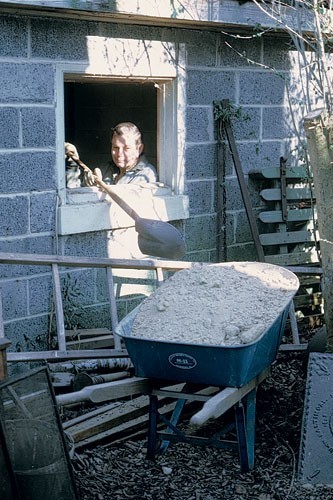
Excavator removing soil from within the car garage over the buried William Rogers’s kiln complex. (Photo, Norman F. Barka.)

View of archaeological excavation of the William Rogers’s pottery complex with portions of the kiln exposed beneath a cinder block garage. (Photo, Norman F. Barka.)
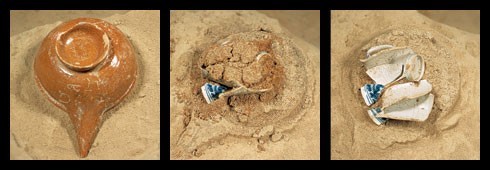
The discovery and excavation of William Rogers’s porringer and London delft capuchinne. (Photos, Norman F. Barka.)
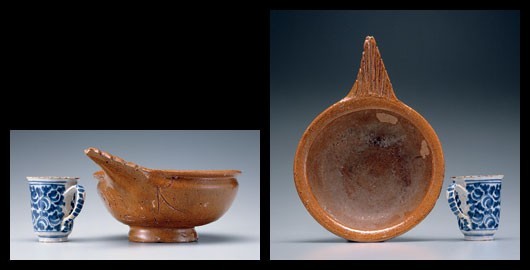
Porringer and coffee cup. Porringer: William Rogers, Yorktown, Virginia, 1720. Lead-glazed earthenware. D. 6 1/2". Coffee cup: London, ca. 1700. Tin-glazed earthenware. H. 2 5/8". (Courtesy, National Park Service, Colonial National Historical Park, Yorktown Collection.) COLO Y 7096, COLO Y 7097. These special objects may represent the material evidence of a dedication rite or ceremony marking the first successful firing of the large kiln. The initials “ag” on the porringer might refer to the initials of the potter, who remains unidentified, and “1720” to the first year of production at the site. The tin-glazed cup, made in London, England, in the period 1700– 1720, would have been especially valued by the potter because of its fine quality; it may also have reaffirmed connections the potter had with the tin-glazing industry in Lambeth or Southwark. In any case, the burial of these pots was likely a special event to ensure good luck in the pottery business. The porringer may be the earliest dated American-made piece ever found in a kiln context.
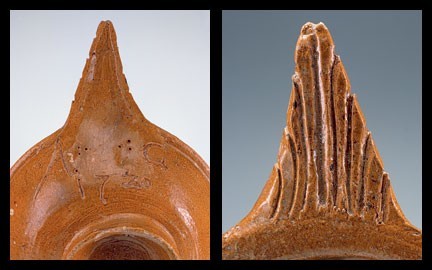
Detail of the back and front of the dedication porringer illustrated in fig. 6. Its solid handle is triangular-shaped with incised parallel line decoration on the upper, flat portion. At least one bisque handle fragment has been found at the site, signifying that the porringer was made at the site.
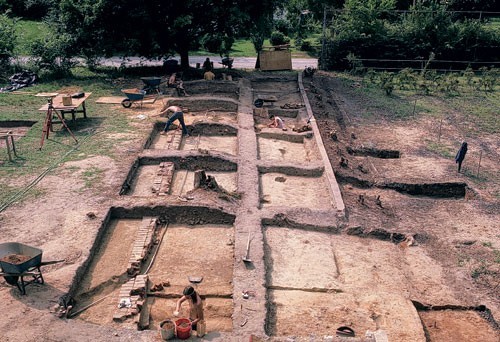
View of the archaeological excavation, facing north. (Photo, Norman F. Barka.) Note the brick foundation of the workshop complex at left.
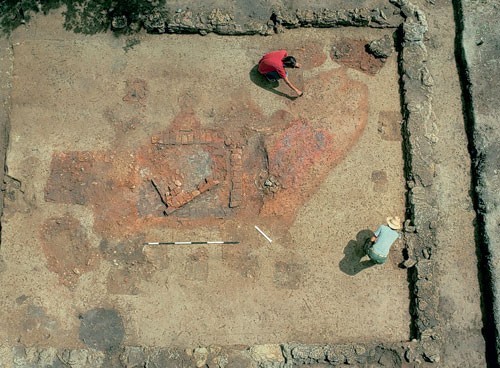
Overhead view of the Small Kiln prior to excavation. (Photo, Norman F. Barka.)
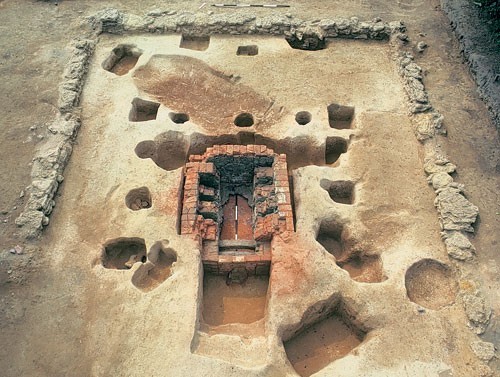
Overhead view of the completed excavation of the Small Kiln. (Photo, Norman F. Barka.) The traces of a marl foundation and a series of postholes represent the remains of the contemporary structures associated with the kiln.
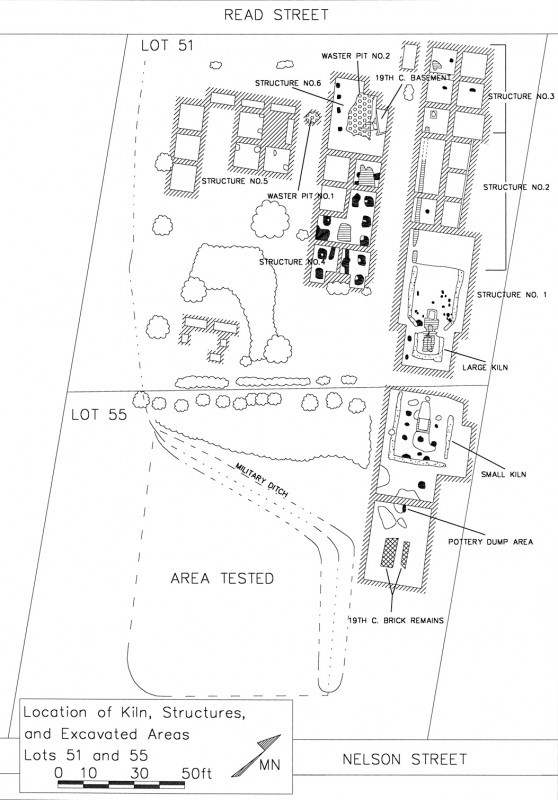
A plan drawing of the excavations detailing the locations of the kilns and related structures and features.
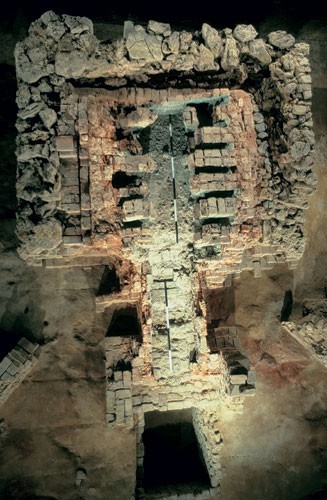
An overhead view of the Large Kiln. (Photo, Norman F. Barka.)
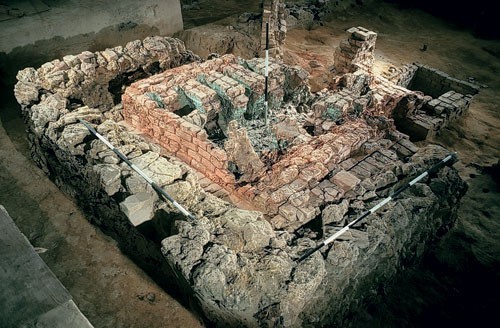
An oblique view of the Large Kiln. (Photo, Norman F. Barka.)
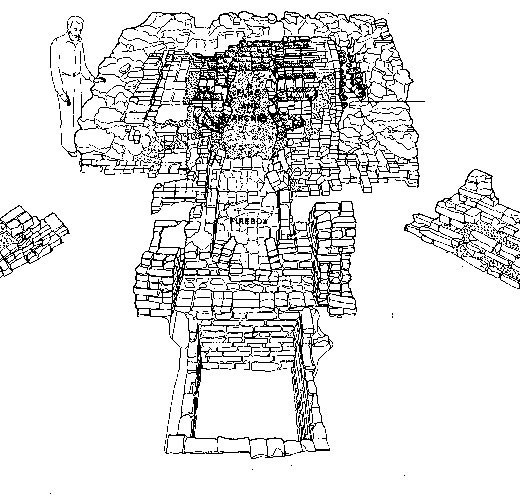
A drawing of the remains of the Large Kiln. (Unless otherwise noted, all drawings courtesy of the Department of Anthropology, College of William and Mary, Williamsburg, Va.)

A cross section of the Large Kiln.
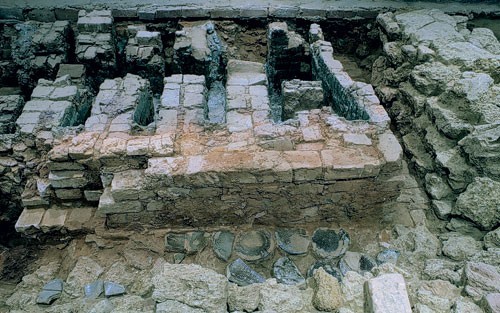
View of the corridor on the west side of the Large Kiln. (Photo, Norman F. Barka.) This area was paved with flat saggar lids, saggar bases, and body fragments. Measuring 1.2 feet wide and 8 feet long, the corridor may have allowed the potter to peer through spy holes in the kiln wall to judge the pot chamber’s temperature.

A view of the excavated Small Kiln, facing south. (Photo, Norman F. Barka.)
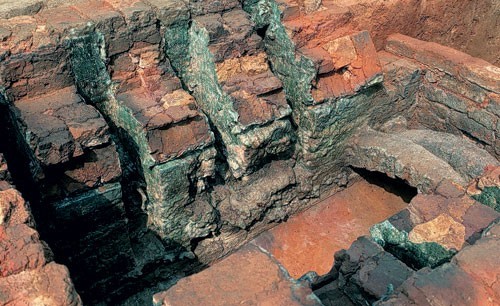
An oblique view of the Small Kiln. (Photo, Norman F. Barka.)
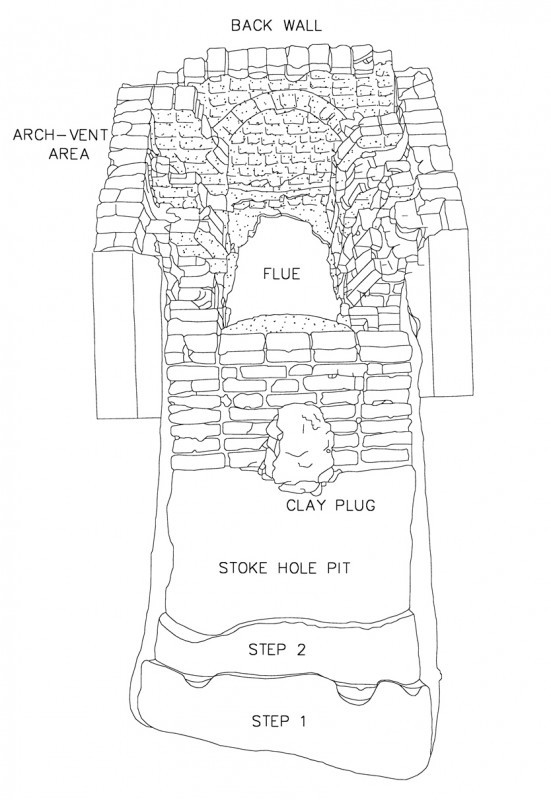
A drawing of the remains of the Small Kiln.
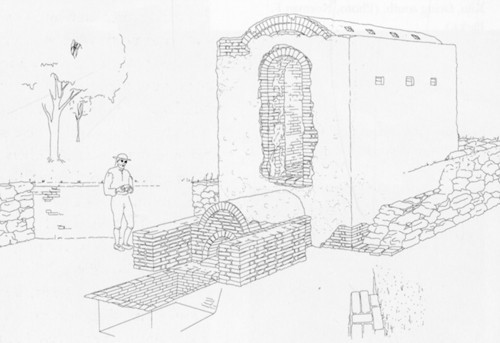
An artist’s reconstruction of the Large Kiln.
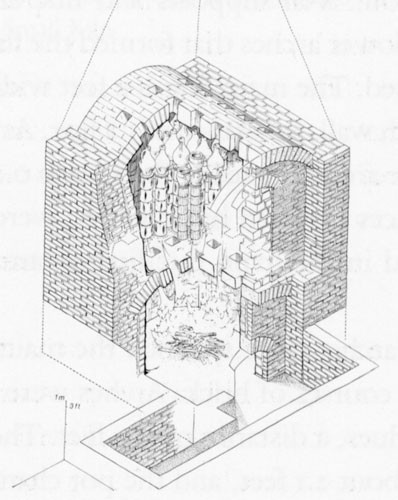
An artist’s reconstruction of an English stoneware kiln similar to the type employed at the William Rogers pottery. (Chris Green, John Dwight’s Fulham Pottery: Excavations 1971–79 [London: English Heritage, 1999], fig. 22; drawing © Chris Green.)
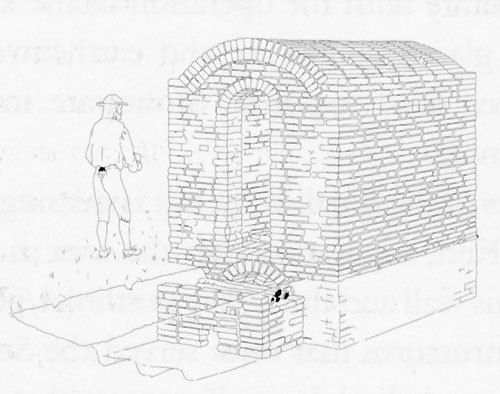
An artist’s reconstruction of the Small Kiln.

Bird bottle, William Rogers, Yorktown, Virginia, 1720–1745. Lead-glazed earthenware. H. 8 1/2". (Courtesy, Department of Archaeological Research, Colonial Williamsburg.) William Rogers’s inventory lists “4 doz bird bottles.”
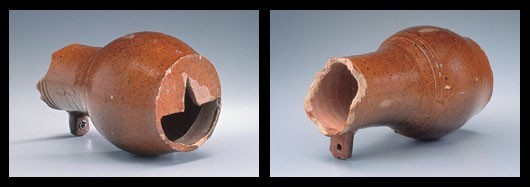
Front and back views of the bird bottle illustrated in fig. 23. Note the perforated tab in the front to seat a dowel, which would serve as a perch. The back of the bottle was cut while the pot was wet (before firing) to provide a notch for hanging under the eaves of a building.
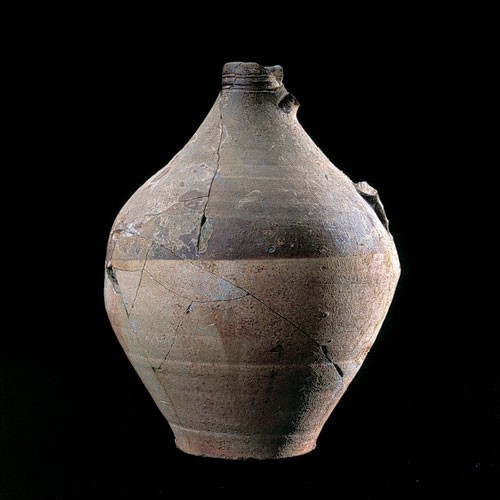
Bottle, William Rogers, Yorktown, Virginia, 1720–1745. Salt-glazed stoneware. H. 10 3/4". (Courtesy, National Park Service, Colonial National Historical Park, Yorktown Collection.) COLO Y71262. In addition to large bottles, a number of fragments from small bottles and flasks (or pocket bottles) were found of the type mentioned in the 1739 inventory. Bottles displayed variation in cordon patterns near the rim, as well as different handle types. A “WR” crown stamp mark is displayed on the shoulder of this example. Capacity seems to vary from one to three gallons, possibly larger.
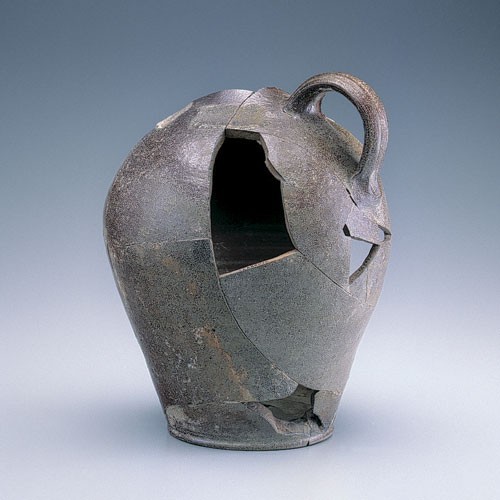
Bottle, William Rogers, Yorktown, Virginia, 1720–1745. Salt-glazed stoneware (lip missing). (Department of Archaeological Research, Colonial Williamsburg.) This example was excavated from an eighteenth-century context in Williamsburg.
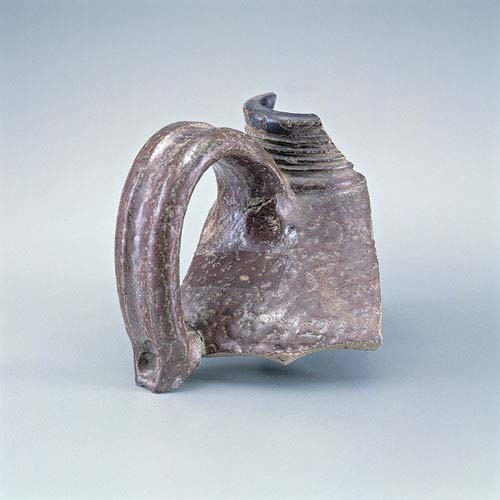
Bottle neck fragment, William Rogers, Yorktown, Virginia, 1720–1745. Salt-glazed stoneware. (Courtesy, National Park Service, Colonial National Historical Park, Yorktown Collection.) COLO Y 15191. This neck fragment is from a large bottle, of three-gallon capacity or possibly more.
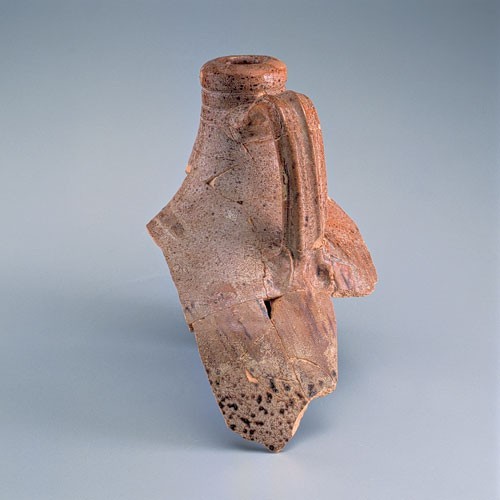
Bottle neck fragment, William Rogers, Yorktown, Virginia, 1720–1745. Lead-glazed earthenware. (Courtesy, National Park Service, Colonial National Historical Park, Yorktown Collection.) COLO Y 15616. This large earthenware bottle fragment is covered in a slip and colored with manganese.
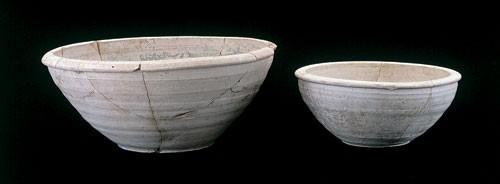
Bowls, William Rogers, Yorktown, Virginia, 1720–1745. Biscuit earthenware. H. 5". (Courtesy, National Park Service, Colonial National Historical Park, Yorktown Collection.) COLO Y 71193, COLO Y 71188. Bowls had up to ten variations in rim style and five basal types. Earthenware forms were fired twice, first to biscuit and then glazed and fired again.

Bowls, William Rogers, Yorktown, Virginia, 1720–1745. Biscuit and lead-glazed earthenware. D. 8 1/2". (Courtesy, National Park Service, Colonial National Historical Park, Yorktown Collection.) COLO Y 71183, COLO Y 71189, COLO Y 71185. Many bowls had a rim diameter of approximately 8", equating to one-quart capacity, although a larger example, with a rim diameter of 20", was excavated.
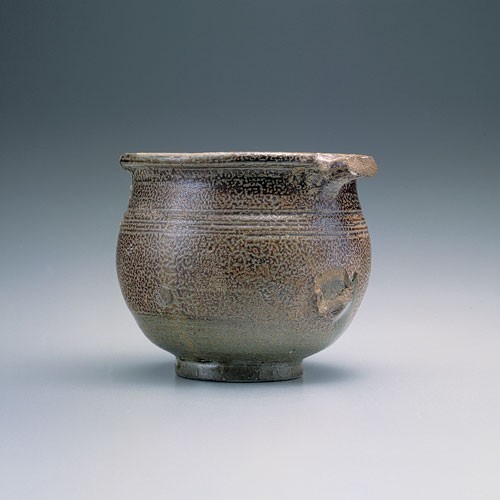
Chamber pot, William Rogers, Yorktown, Virginia, 1720–1745. Salt-glazed stoneware. H. 5 3/4". (Courtesy, National Park Service, Colonial National Historical Park, Yorktown Collection.) COLO Y 14270. Many size variations of both stoneware and earthenware chamber pots were found on the site. A lead-glazed earthenware vessel without handles was recovered that would have served as the receptacle in a closestool.
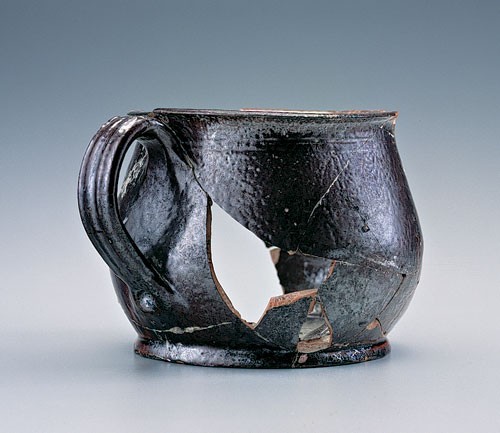
Chamber pot, William Rogers, Yorktown, Virginia, 1720–1745. H. 5 1/2". Lead-glazed earthenware. (Department of Archaeological Research, Colonial Williamsburg.) This warped and overfired example was recovered from a well in Williamsburg, indicating that Rogers’s seconds had a market.
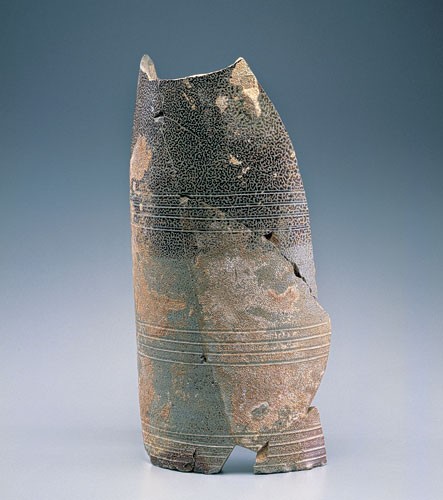
Churn, William Rogers, Yorktown, Virginia, 1720–1745. Salt-glazed stoneware. H. (approx) 17 1/2". (Courtesy, National Park Service, Colonial National Historical Park, Yorktown Collection.) COLO Y 14427a. This tall cylindrical form tapers in circumference from base to mouth. It is one of the few forms to have been decorated with incised leaf and flower motifs. One fragment with a hole in its center may be a churn lid. The Yorktown churns may be the earliest clay butter churns made in America
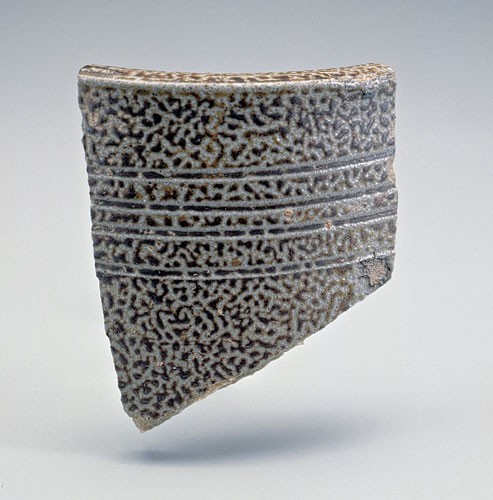
Detail of rim fragment associated with the churn illustrated in fig. 33. (Courtesy, National Park Service, Colonial National Historical Park, Yorktown Collection.) COLO Y 14427b. Note the heavy iron oxide wash evident on this example.
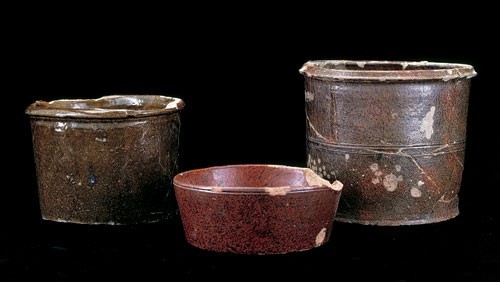
Cream jars and saucepan, William Rogers, Yorktown, Virginia, 1720–1745. Lead-glazed earthenware. H. 4 13/16", 2 3/8", and 7 3/8". (Courtesy, National Park Service, Colonial National Historical Park, Yorktown Collection.) COLO Y 71195, COLO Y 71184, COLO Y 71196.
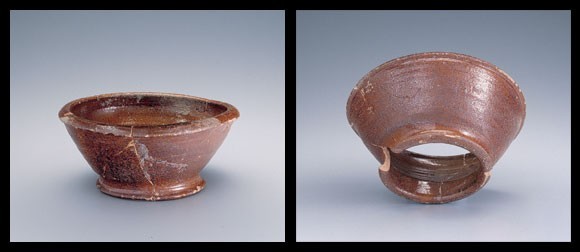
Funnel, William Rogers, Yorktown, Virginia, 1720–1745. Lead-glazed earthenware. H. 4 1/2". (Department of Archaeological Research, Colonial Williamsburg.) This lead-glazed, bowl-like form has two open ends, one smaller than the other for channeling ingredients from one container to the other.

Jar, William Rogers, Yorktown, Virginia, 1720–1745. Lead-glazed earthenware. H. 13 1/2". (Courtesy, National Park Service, Colonial National Historical Park, Yorktown Collection.) COLO Y 71198. Both lead-glazed earthenware and salt-glazed stoneware storage jars were apparently made in large quantities. The heights of the measurable examples range from 71/2" to 17". These heights may conform to a standard range of sizes from one-half gallon up to as large as five gallons.
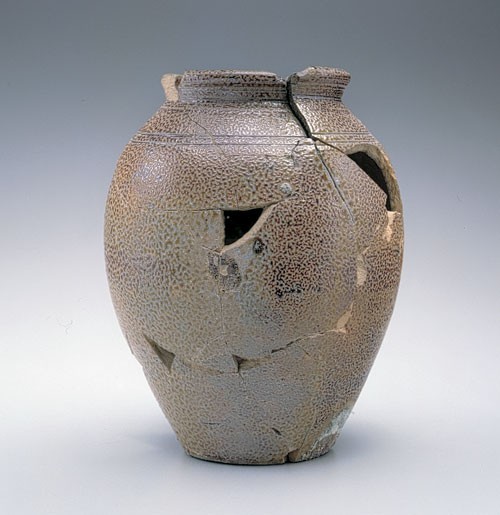
Jar, William Rogers, Yorktown, Virginia, 1720–1745. Salt-glazed stoneware. H. 10". (Courtesy, National Park Service, Colonial National Historical Park, Yorktown Collection.) COLO Y15072. The upper portion of this typical stoneware jar has been dipped in iron oxide. Handles are present only on the largest examples.
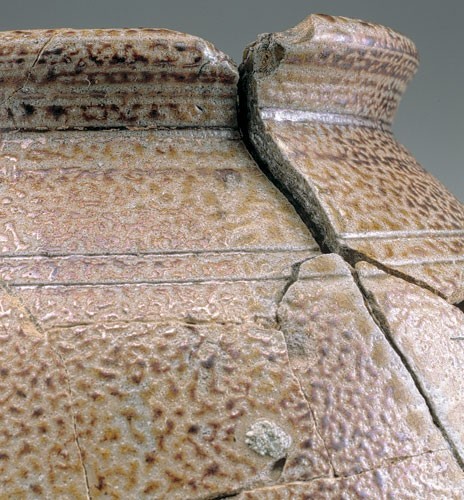
Detail of the jar illustrated in fig. 38. Note the major distortion along the firing crack that helps identify this jar as a waster.

Milk pans, William Rogers, Yorktown, Virginia, 1720–1745. Biscuit and lead-glazed earthenware. D. 13 1/2– 14 1/2". (Courtesy, National Park Service, Colonial National Historical Park, Yorktown Collection.) COLO Y 71251, COLO Y 71253. These wide, flat-based vessels have curved, out-sloping walls and one spout in the rim. While most examples were bisque and lead-glazed earthenwares, a few stoneware milk pans were found. Pans were partially glazed, mostly on the interior, and showed sixteen rim variants. Heights vary from 2–4", with the majority measuring 3 1/2". Rim diameters also vary from 10–19", with the majority measuring 16". Base diameters measure from 6–9".
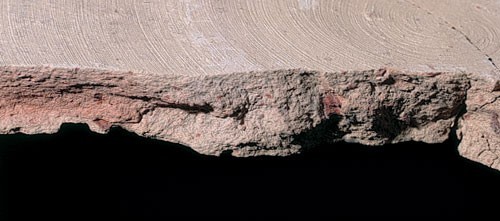
Detail of cross section of the bisque clay body of the milk pan illustrated at left in fig. 40. Note the brick red inclusions of hematite, a characteristic of the Rogers’s pottery earthenware.
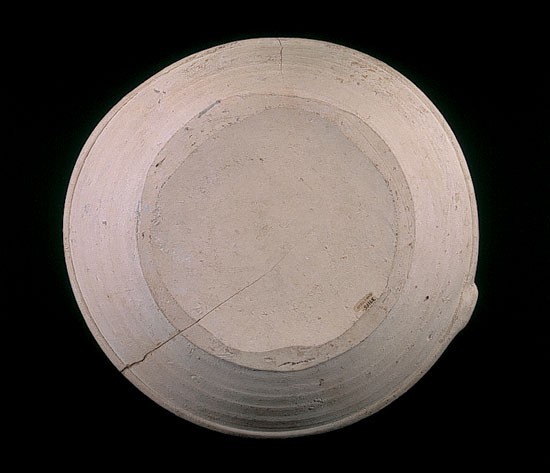
Milk pan, William Rogers, Yorktown, Virginia, 1720–1745. (Courtesy, National Park Service, Colonial National Historical Park, Yorktown Collection.) COLO Y 71220. After throwing, excess clay at the base was cut off with a knife or tool, as indicated by the marks on this example.
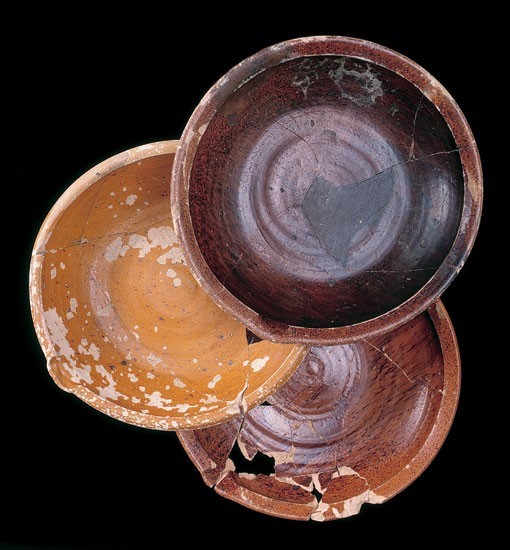
Milk pans, William Rogers, Yorktown, Virginia, 1720–1745. (Courtesy, National Park Service, Colonial National Historical Park, Yorktown Collection.) COLO Y 71191, COLO Y 71252, COLO Y 71199. Note the wide range of color due to variation in the firing environment within the kiln.
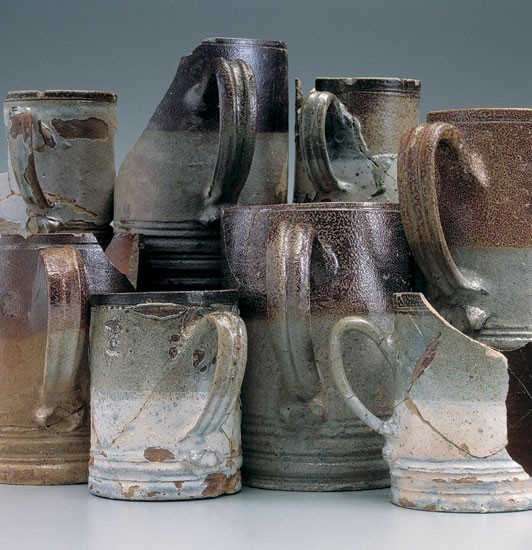
Mugs, William Rogers, Yorktown, Virginia, 1720–1745. Salt-glazed stoneware. (Courtesy, National Park Service, Colonial National Historical Park, Yorktown Collection.) One of the most common forms produced by William Rogers was the tavern mug. Bisque and glazed earthenware and stoneware were recovered. Earthenware mugs, yellow in color, were dipped in white slip or finished with a green glaze of dark brown or red-brown. Yorktown stoneware mugs were manufactured in the following sizes a few mug bases, large in diameter, were probably one quart in capacity. The stoneware mug (together with the teapot) was the highest quality pot made by the “poor potter.” Its appearance and excellent potting rivaled those made in England; in fact, more time and care were spent making the Yorktown mugs, as they were the only form fired in saggars. Thirteen small stoneware mugs, each 3 1/2" high and 2 1/2" in diameter, appear to have been test pieces; all were found in association with the Small Kiln. Several show one or more slashlike incisions and some show evidence of a white slip, which in some cases had clearly peeled off the mugs but in others had produced a smooth white “glaze” under the salt glaze.
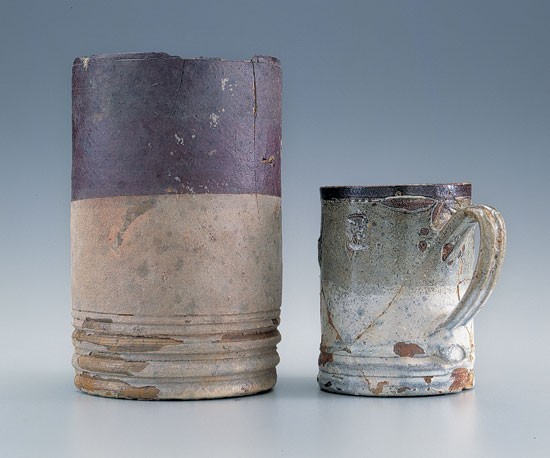
Mugs, William Rogers, Yorktown, Virginia, 1720–1745. Salt-glazed stoneware. H. 5 7/8" and 3 9/16". (Courtesy, National Park Service, Colonial National Historical Park, Yorktown Collection.) COLO Y 71102, COLO Y 10,884. The upper half of a stoneware mug was usually dipped in iron oxide and the lower part was sometimes dipped in white slip. Each mug has one strap handle, with the lower terminal folded back on itself and impressed.

Mug, William Rogers, Yorktown, Virginia, 1720–1745. Salt-glazed stoneware. H. 3 1/2". (Courtesy, National Park Service, Colonial National Historical Park, Yorktown Collection.) COLO Y 47098. Many stoneware mugs are stamped with the initials “wr” beneath a crown, both of which are in relief within a depressed rectangle. The majority of these stamps are located to the left of the handle.
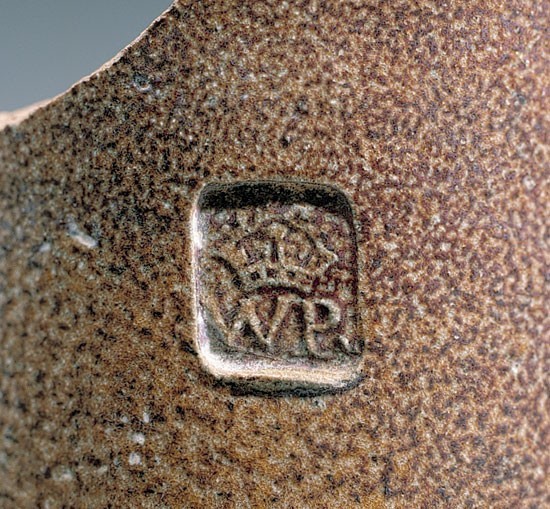
Detail of the “WR” excised mark on the mug illustrated in fig. 46. In 1700, during the reign of William III, regulation of the capacity sizes of tavern mugs was enacted that required vessels to be measured during manufacture and stamped with “WR” below a crown. It is interesting to observe that Rogers continued marking his products even though he was beyond the government’s accountability for his wares. Perhaps these marks helped reassure his tavern keeper clients as to the veracity of the measures.
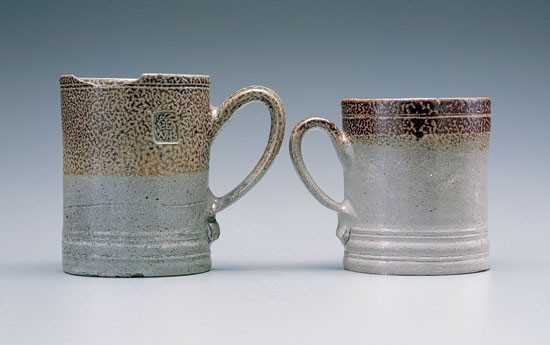
Mugs, William Rogers, Yorktown, Virginia, 1720–1745. Salt-glazed stoneware. H. 3 1/2" and 3 1/8". (Courtesy, National Park Service, Colonial National Historical Park, Yorktown Collection.) COLO Y 7098, COLO Y 7099..
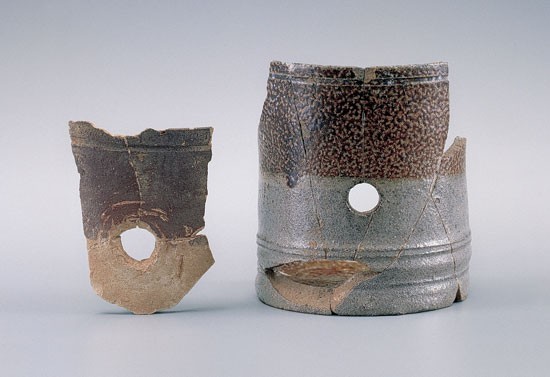
Mug fragments, William Rogers, Yorktown, Virginia, 1720–1745. Salt-glazed stoneware. H. (right) 2 1/2". (Courtesy, National Park Service, Colonial National Historical Park, Yorktown Collection.) COLO Y 10,896, COLO Y 10,942. The function of the holes in these mugs has never been satisfactorily explained, but one suggestion is that they served as trial pieces which could have been extracted from the kiln during firing to check on the quality of glazing.
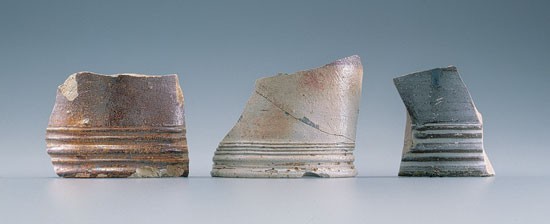
Mug base fragments, William Rogers, Yorktown, Virginia, 1720–1745. Salt-glazed stoneware. (Courtesy, National Park Service, Colonial National Historical Park, Yorktown Collection.) COLO Y 10,927, COLO Y 10,928, COLO Y 10,929. These examples show some of the variation in the cordoning treatment on the base of Rogers’s mugs. At least eleven cordon variations occur on the mugs.
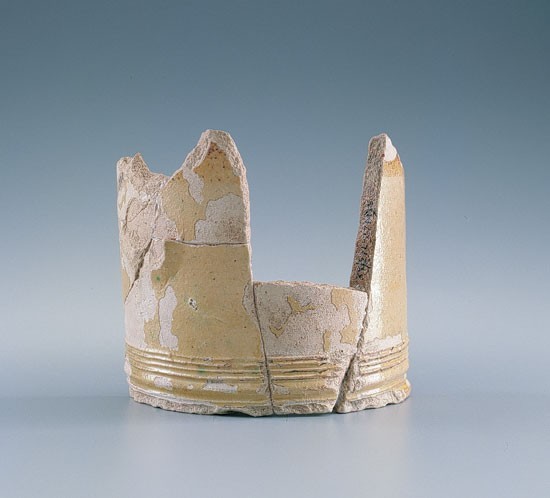
Mug base fragment, William Rogers, Yorktown, Virginia, 1720–1745. Lead-glazed earthenware. Diam. (approx.) 4". (Courtesy, National Park Service, Colonial National Historical Park, Yorktown Collection.) COLO Y 10,919. Some of the earthenware mugs were covered in a white slip before glazing; none yet identified bears the impressed “wr” stamp.

Pipkin, William Rogers, Yorktown, Virginia, 1720–1745. Lead-glazed earthenware. H. 4 1/8". (Courtesy, National Park Service, Colonial National Historical Park, Yorktown Collection.) COLO Y 71194. Earthenware pipkins are cooking pots with a flat base or three legs, bulbous walls with a rim spout, and a solid or open handle applied at an angle. The handles are tapered and pulled, with cut or pinched-off ends. Some pipkins had large, hollow-thrown handles into which a wooden dowel could be inserted. Stonewares are thrown, solid cylinders, measuring 4 1/2" in rim diameter, 3 1/2" at base, and 4 1/2" high. This nearly complete lead-glazed example shows how they were stacked directly on top of each other in the kiln. One footed pipkin, mostly lead-glazed with a wide cylindrical handle, was found in Gloucester Town, an eighteenth-century settlement facing Yorktown across the York River.
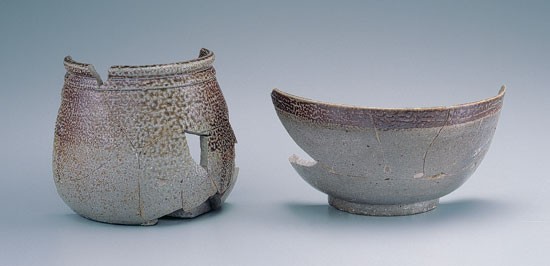
Pipkin and bowl, William Rogers, Yorktown, Virginia, 1720–1745. Salt-glazed stoneware. H. of pipkin: 4 1/8". (Department of Archaeological Research, Colonial Williamsburg.) These are examples of Rogers’s domestic stoneware vessels excavated in Williamsburg.
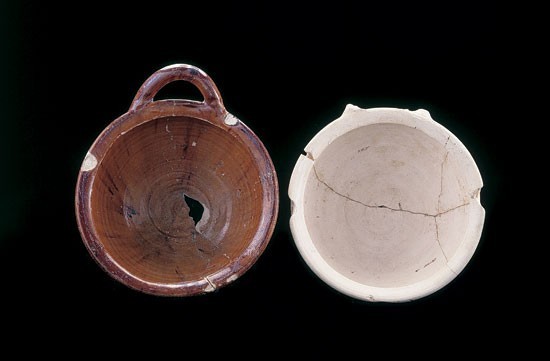
Porringers, William Rogers, Yorktown, Virginia, 1720–1745. Lead-glazed earthenware. Diam. 7". (Courtesy, National Park Service, Colonial National Historical Park, Yorktown Collection.) COLO Y 71190, COLO Y 71182. These bowl-like vessels have a flat base, curved out-sloping walls, flattened and usually down-sloping (toward the interior) rims, and a C-shaped, circular-sectioned handle attached to the rim. As with most of Rogers’s earthenwares, the porringer has a reduced gray-green to red-orange color related to the kiln temperature and the atmosphere in the kiln.

Stove tile, William Rogers, Yorktown, Virginia, 1720–1745. Earthenware. 7" square. (Courtesy, National Park Service, Colonial National Historical Park, Yorktown Collection.) COLO Y 8722a. This square tile has a raised design on one surface and an encircling wall or flange applied at right angles to the back of the flat tile. One-half of a complete specimen and 435 other fragments were found, all bisque; only three glazed fragments were found. The surface of the molded tile is decorated with a swag, six leaves, a pomegranate, and a flower. The total estimated sample found is 44 separate tiles. Stove-tile manufacture in Yorktown suggests the presence of a Dutch or German potter, as tile stoves were popular in Europe during the eighteenth century but not in England. Stove tiles of this type were also made in Moravian areasof North Carolina.
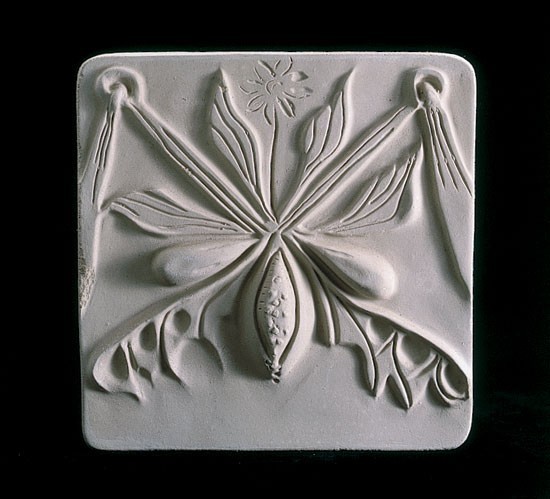
An artist’s clay reconstruction of a William Rogers stove tile. (Courtesy, Patricia Kandle.)
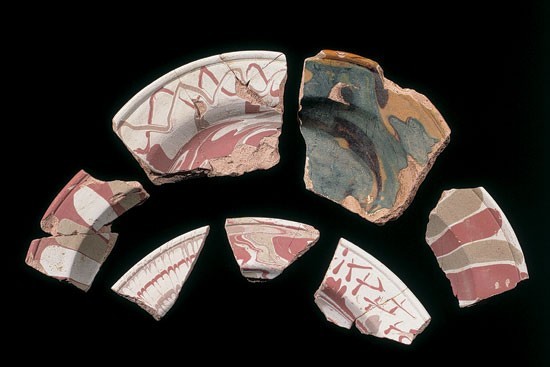
Dish fragments, William Rogers, Yorktown, Virginia, 1720–1745. Slipware. (Courtesy, National Park Service, Colonial National Historical Park, Yorktown Collection.) COLO Y 11490, COLO Y 11450, COLO Y 11854, COLO Y 11566, COLO Y 11853. A number of fragments from large, wide-rimmed low dishes with flat bases were recovered from the site. This form is usually slip-decorated but sometimes plain. The method of slip decoration includes trailing, combing, and marbleizing. These dishes range in diameter from 10–15" (with the majority being 14") and are about 2" high. They have a red to pinkish body, with glazed pieces usually yellow in color. The interior is lead-glazed. No examples of this important ceramic type have ever been found outside of the immediate pottery site.
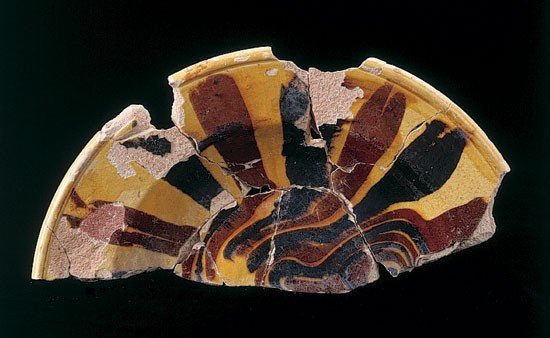
Dish fragment, William Rogers, Yorktown, Virginia, 1720–1745. Slipware. (Courtesy, National Park Service, Colonial National Historical Park, Yorktown Collection.) COLO Y 71192. This highly unusual slipware dish employed lines of red and black slip trailed over a white ground slip and subsequently joggled to create the marbleized center pattern.
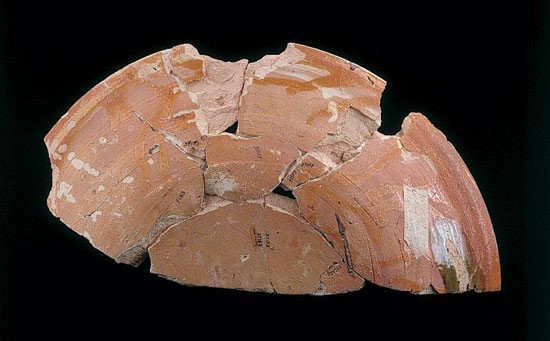
Reverse of the slipware dish fragment illustrated in fig. 58.

Saggars, William Rogers, Yorktown, Virginia, 1720–1745. H. 5", 5 1/2", and 5". (Courtesy, National Park Service, Colonial National Historical Park, Yorktown Collection.) COLO Y 15928, COLO Y 38766, COLO Y 15934. A variety of saggars were employed at the Rogers’s pottery to protect the stoneware mugs during firing. Made of refractory clay, the Yorktown saggars have four openings cut into the walls, permitting the entrance of heated air and volatilized salt. Three of the openings are teardrop-shaped; the fourth is a wide rectangular slit cut through the rim to facilitate air movement and subsequent removal of the glazed mug. Most saggars are heavily coated with salt glaze because of repeated use. Saggars range in diameter and height from 4–10", although there seem to have been three main sizes (corresponding to the different size stoneware mugs). The largest saggars are 9–10" in height and weigh about 8–10 pounds each. Saggars were stacked in columns in the kiln’s pot chamber. The kiln’s topmost saggar was topped by a lid. Individual saggars and stoneware pots were separated from one another—to prevent sticking during salt glazing—by props, pads, and wads of refractory clay generally referred to as kiln furniture. Thousands of saggar fragments and pieces of kiln furniture were found throughout the site.

Teapot fragments, William Rogers, Yorktown, Virginia, 1720–1745. Salt-glazed stoneware. (Courtesy, National Park Service, Colonial National Historical Park, Yorktown Collection.) COLO Y 37515, COLO Y 9813, COLO Y 9815, COLO Y 9816, COLO Y 9817. In addition to the large variety of coarse utilitarian ware, a number of finely thrown teaware pots were produced. Both lead-glazed and salt-glazed stoneware were found. These pots generally measured 4" high with a rim and basal diameter of 4". No examples of Rogers’s teawares have been identified outside of the pottery site.
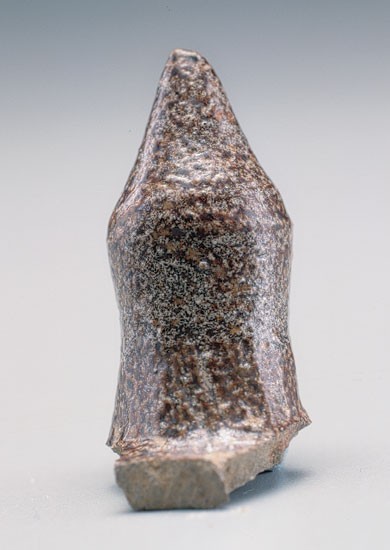
Coffee pot lid knop. William Rogers, Yorktown, Virginia, 1720–1745. Salt-glazed stoneware. (Courtesy, National Park Service, Colonial National Historical Park, Yorktown Collection.) COLO Y 9822. The shape and size of this fragment, based on parallels with English examples of the period, suggest that William Rogers may also have been making coffee pots.
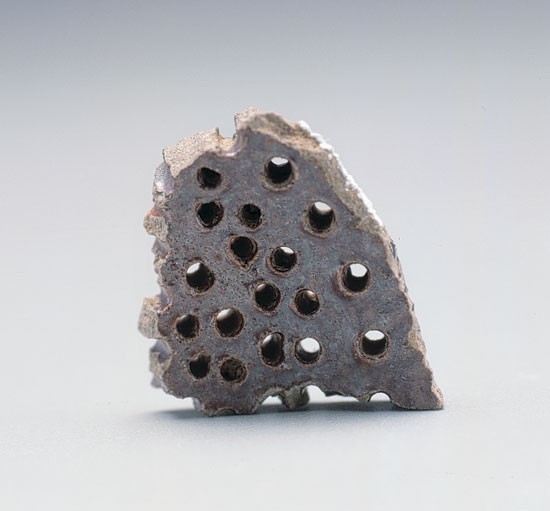
Fragment of a strainer from the interior of a salt-glazed stoneware teapot. (Courtesy, National Park Service, Colonial National Historical Park, Yorktown Collection.) COLO Y 9824.
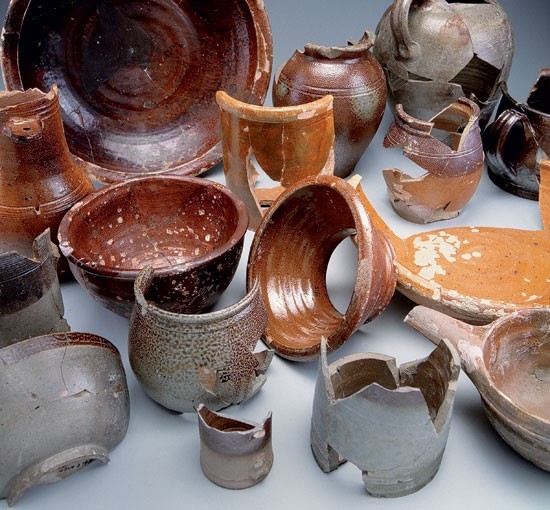
Probable examples of William Rogers earthenwares and stonewares, 1720–1745, excavated in Williamsburg. (Department of Archaeological Research, Colonial Williamsburg.) The success of William Rogers’s pottery can be measured by the widespread distribution of his finished wares. Examples of his utilitarian forms are found at archaeological sites throughout the tidewater region of Virginia, with specimens also being reported from Maryland and North Carolina. Historical evidence suggests his wares may even have reached Caribbean ports.
